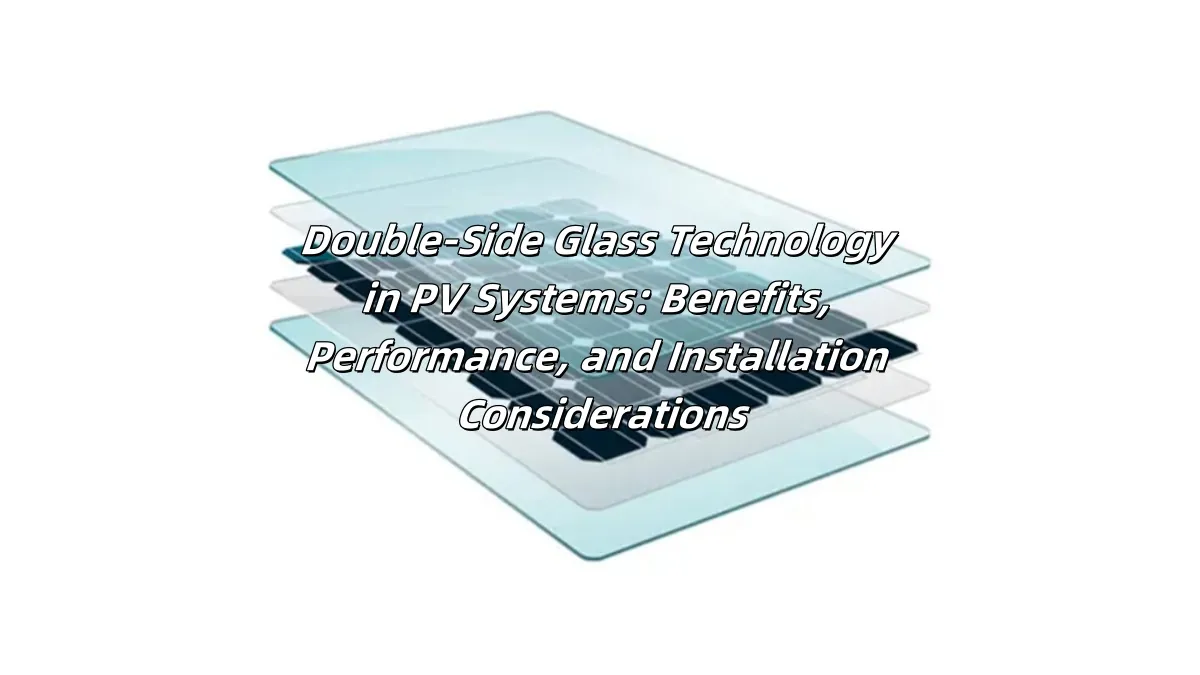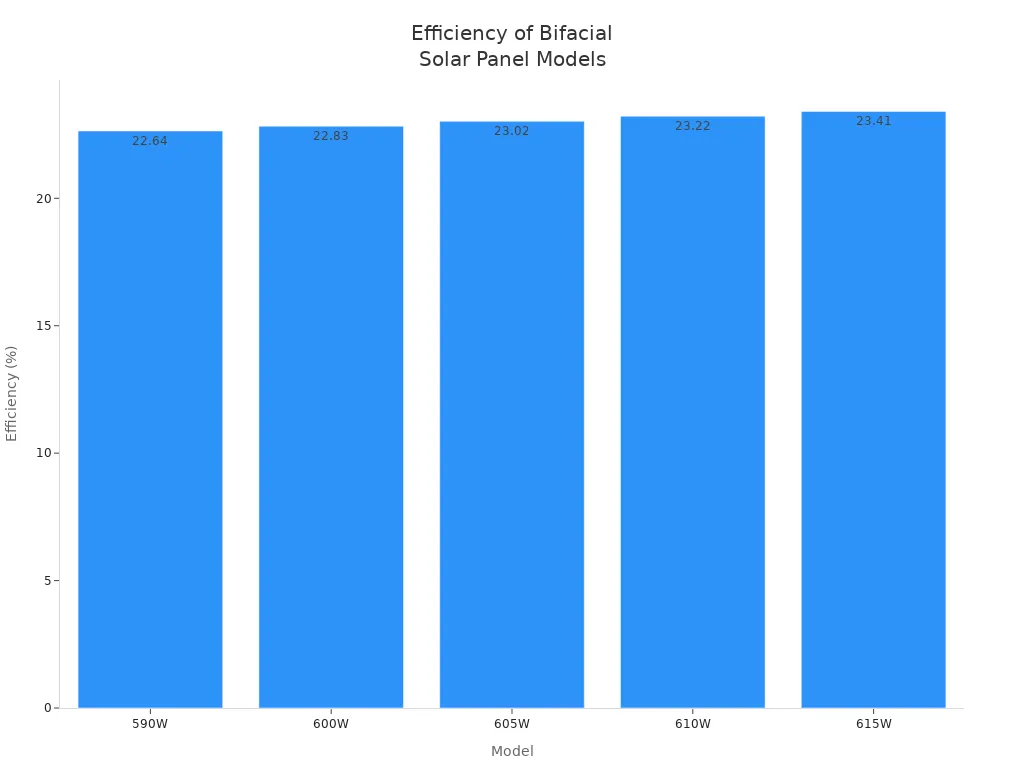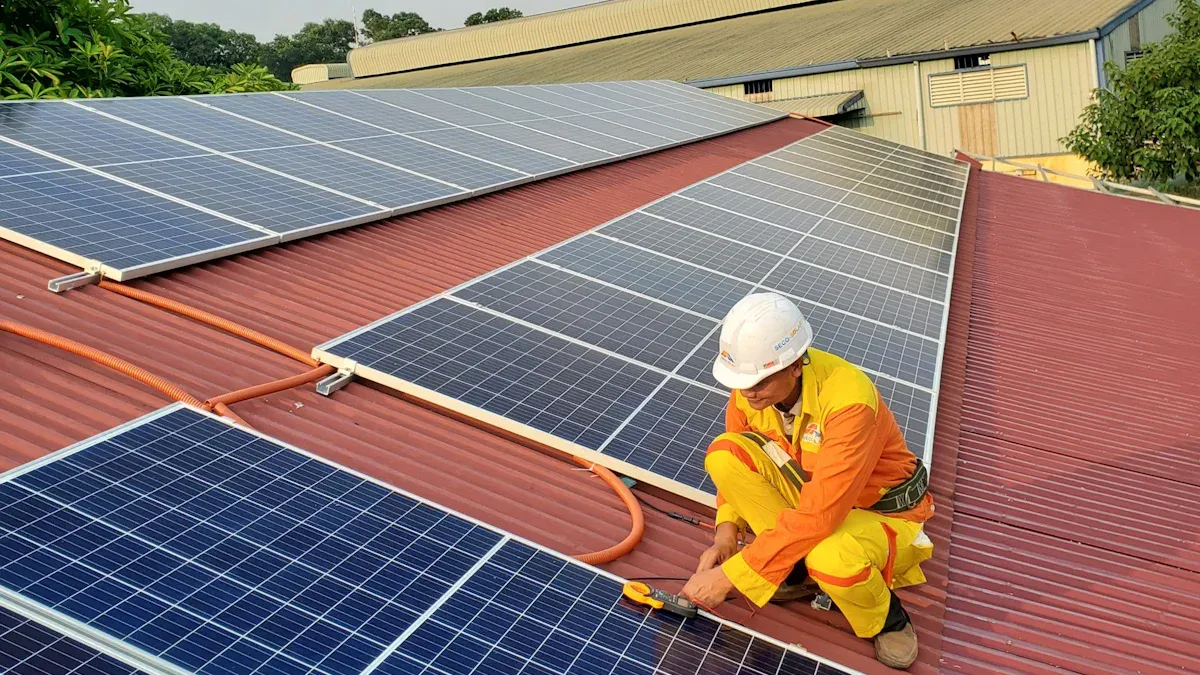+86 17727759177
inbox@terli.net
- All
- Product Name
- Product Keyword
- Product Model
- Product Summary
- Product Description
- Multi Field Search
Views: 0 Author: Site Editor Publish Time: 2025-09-06 Origin: Site
You see double side glass technology in bifacial solar panels. These panels take in sunlight from both sides. This helps you make more energy. Many people find the cost is higher. The setup can be hard for some users. You may worry about how well these panels work. Sunlight does not always hit them the same way. Some people think bifacial panels fit every roof. They work best on flat commercial roofs or ground mounts.

Bifacial solar panels take in sunlight from both sides. This helps them make 5% to 30% more energy than regular panels. Double side glass technology makes panels stronger. It helps them handle bad weather and last over 25 years. Pick places with bright surfaces like white gravel for installation. This helps panels make more energy from light that bounces off the ground. Clean both sides of the panels often. This keeps them working well and helps them last longer. Bifacial panels cost more at first. But they save more money over time because they use energy better.
Bifacial solar panels look different from regular panels. They use both sides to take in sunlight. The front side gets sunlight straight from the sun. The back side catches light that bounces off the ground or things nearby. This helps you make more energy in the same space. These panels work best where the ground is bright and shiny, like snow or sand. White rooftops also help. You can use bifacial panels in many places. They work best in open spots where both sides get lots of light.
Tip: To get more solar power, try bifacial panels in places with lots of reflected sunlight.
Double side glass technology makes bifacial panels special. These panels have glass on both the front and back. The glass keeps the solar cells safe inside. Regular panels have glass only on the front. The back is usually plastic or another material. The double glass makes bifacial panels stronger. They can handle bad weather, water, and rust better. This means the panels last longer and keep working well. The glass lets light go through to the back. This helps the panel use sunlight from both sides.
| Feature | Monofacial Panels | Bifacial Panels |
|---|---|---|
| Sunlight Capture | Only the front side takes in sunlight. | Both sides take in sunlight. |
| Efficiency | Only uses direct sunlight on the front. | Can use extra light that bounces off the ground. |
| Energy Output | Makes energy from sunlight on the front only. | Makes more energy by using both sides. |
| Design | The back is not see-through, usually black or white. | The back is glass, so light can go through. |
| Cost | Usually costs less money. | Costs more at first but saves more later. |
| Best Use Cases | Good for places with direct sunlight. | Best for places with shiny ground like snow. |
Double side glass and bifacial panels give you more for your money. These panels can make up to 30% more energy than regular ones. They use both sides to catch sunlight. The strong glass keeps the cells safe from weather and water. The panels last longer and work better over time. If you want a solar system that works hard and lasts long, bifacial panels with double side glass are a smart pick.
If you pick bifacial solar panels with double side glass, you get more energy from the same spot. These panels use both sides to catch sunlight. This means you get power from both the front and back. The front side takes in sunlight directly. The back side grabs light that bounces off the ground or things nearby. This setup makes more electricity and gives you higher energy output.
Bifacial panels can make 5% to 30% more energy than regular panels. How much more depends on where you put them and what is under them. If you put them over bright or shiny surfaces, like white roofs or snow, you get even more extra energy. This extra power helps you save money and pay off your solar system faster.
Double side glass technology helps the panels cool down better when making power. This keeps your panels cooler and working well, even when it is hot outside. You get better performance and higher efficiency in all kinds of light, even on cloudy days. Over time, this means you get steady energy and better results from your solar investment.
Note: Bifacial solar panels often have better warranties because they last longer. You can count on them to make strong energy for many years.
You want your solar panels to last a long time. Double side glass panels are very tough. Both sides use tempered glass to protect the solar cells from water, rust, and bad weather. This design helps your panels stand up to wind, hail, and heavy snow. The glass also keeps the cells safe from sun damage and high humidity, which can hurt regular panels.
The laminated build makes these panels strong and steady. You do not need to worry about the back film peeling or breaking. Double side glass panels are PID-free, so you do not get problems that lower power in other systems.
Tests show these panels last longer than normal ones. You can expect them to work for 25 years or more. Some can last up to 30 years. The table below shows how long different panels last:
| Type of Solar Panel | Average Lifespan |
|---|---|
| Double Side Glass Panels | 25 years or more |
| Traditional Glass Panels | 20 to 30 years |
Bifacial panels lose power slower than regular panels. Some new models lose less than 1% in the first year and only about 0.4% each year after that. Regular panels lose about 0.5% to 0.7% each year. This means bifacial panels keep making more electricity for a longer time.
Bifacial panels lose 0.25-0.35% power each year.
Standard panels lose 0.5% to 0.7% power every year.
After 15 years, bifacial panels may lose only 5% of their power, while standard panels can lose 12-15%.
Tip: With stronger panels and slower power loss, you get more steady solar energy and better results for your system.
Double side glass solar panels help you care for the planet. When you recycle these panels, you get back important materials like silicon, glass, and rare metals. Recycling cuts down on waste and lowers greenhouse gases. It also means less mining and less energy use, which saves natural resources.
Bifacial solar panels are great for big solar projects. They make more energy and shrink the carbon footprint of your solar systems. By using better panels, you use less fossil fuel and help protect nature. Recycling solar panels also creates jobs and helps keep the earth clean.
| Benefit | Description |
|---|---|
| Increased Energy Production | Bifacial panels catch sunlight from both sides, so you get more energy. |
| Reduced Carbon Footprint | Better efficiency means fewer greenhouse gases. |
| Conservation of Resources | Using solar power means less fossil fuel and helps nature. |
♻️ Picking bifacial solar panels with double side glass gives you clear benefits for energy, strength, and the environment. You help the earth and get more from your solar system.
You want your solar system to work well. It should work even when the sun is behind clouds. It should also work in the morning and late afternoon. Bifacial solar panels help you get more energy in low light. These panels use both sides to catch sunlight. You do not lose as much power when the light is weak.
Many people see about 15% better performance in low light. Some people notice a 4% improvement. This happens when panels have a small tilt or sit close to the ground. The way you set up your panels changes how much energy you get. Azimuth and tilt are important. Sometimes, the difference in power is small. Bifacial panels still give you a boost.
Bifacial panels work better when it is cloudy.
You get more energy when the sun is low.
How you set up your panels affects extra power.
️ Tip: If you live where it is cloudy a lot, bifacial solar panels help keep your energy steady.
You may wonder how bifacial panels compare to regular panels. The main difference is how they use sunlight. Monofacial panels only take in light from the front. Bifacial panels use both sides to catch sunlight. This helps them make more energy.
Here is a table that shows how the two types compare:
| Type of Panel | Efficiency Level | Additional Information |
|---|---|---|
| Monofacial Panels | 18-22% | Absorb sunlight on one side only. |
| Bifacial Panels | 5-30% more than monofacial | Capture sunlight on both sides, improving energy output. |
Bifacial panels with double side glass reach higher efficiency ratings. You can see the difference in the table below:
| Model | Efficiency (%) |
|---|---|
| 590W | 22.64 |
| 600W | 22.83 |
| 605W | 23.02 |
| 610W | 23.22 |
| 615W | 23.41 |

You get more energy and higher efficiency with bifacial panels. This is true when you put them over bright surfaces like snow or sand. The double-glass design helps panels last longer. It also helps them work better in tough weather.
You see bifacial solar panels with double side glass in many places. These panels work well in ground-mount systems with light gravel or sand. You find them on commercial rooftops with shiny surfaces. Carports and solar farms use bifacial panels to make more energy.
Ground-mount systems with light gravel or sand
Commercial rooftops with shiny surfaces
Carports and solar farms with open space under the panels
Bifacial panels handle harsh weather well. Snow and sand bounce sunlight to the back of the panels. This helps make more energy. The double-glass design lets light go through and keeps panels strong. You can track energy from both sides for better monitoring.
You get solar energy in places with tough weather. Bifacial panels catch direct sunlight and reflected light. You get more energy, better strength, and higher efficiency. Your solar system works well in many conditions and gives you steady power.

Image Source: pexels
You want your bifacial solar panels to work well. The place you pick is important for how much energy you get. Choose spots with high-albedo surfaces, like white gravel or shiny rooftops. These surfaces bounce sunlight onto both sides of the panels. This helps make more electricity. Lift your panels at least one meter above the ground. This helps them catch more light from below. Keep rows at least 2.5 meters apart so sunlight can reach the back. Use shiny materials or diffusers around your solar system to spread more light. Plan where cables go so they do not block the panels.
Site Selection Checklist:
Lift panels up for better light on the back.
Leave space between rows to stop shading.
Pick places with shiny ground.
Use diffusers and shiny mounting parts.
Put cables where they will not block light.
Tip: Open spaces with bright ground help bifacial solar panels make more power.
How you mount the panels changes how well they work and what it costs. Double side glass panels are heavier than regular ones. You need strong mounts to hold them up. Workers may get tired faster because of the extra weight. Use mounts that let light go through or bounce onto the panels. Do not use mounts that make shadows on the back. Adjust the mounts to stop the glass from bending. This keeps the panels safe. You can use single-axis trackers to follow the sun. This can help make up to 35% more energy. Tilt the panels south to get the most sun. Leave more space between rows for better light on the back.
| Strategy | Description |
|---|---|
| Elevated Mounting | Lifts panels for more light on the back. |
| Tilt Optimization | Face panels south and tilt more for better results. |
| Tracking Systems | Trackers help make more energy and work better. |
| Reflective Ground Materials | White gravel helps make more energy from the back. |
You want your solar panels to last a long time and keep making power. Bifacial solar panels need to be cleaned on both sides. This removes dust, pollen, and bird droppings. Clean the shiny layer on the back to keep the panels working well. Check the panels often for dirt, damage, or loose wires. Use built-in tools or write down how much energy you get to find problems early. Cut tree branches to stop shade and use guards to keep animals away. Make sure the panels tilt so water does not collect. Double side glass panels are strong, so they break less. But they may need more care because they are more complex than single-sided panels.
Note: Cleaning and checking your panels often helps your solar system work well for many years.
You get lots of good things with double side glass bifacial panels. These panels last a long time. They can handle bad weather. They work well even when it is cloudy. You can put them on rooftops, carports, or on the ground. The table below shows why people pick this solar technology:
| Advantage | Description |
|---|---|
| Efficiency | Both sides make more power for your system. |
| Durability | Strong glass keeps the panels safe from harm. |
| Long life | Panels can work for up to 30 years. |
Tip: Think about where you live, how much money you have, and how much care your solar panels will need before you upgrade.
Bifacial panels use both sides to catch sunlight. The front side takes direct sun. The back side grabs light that bounces off the ground. You get more energy from the same space.
Tip: Place panels over bright surfaces for best results.
You need strong mounts because these panels weigh more. Workers must lift and set them with care. You should leave space under and around the panels for light to reach both sides.
Use sturdy mounting systems.
Keep panels raised for better performance.
You pay more at first for bifacial panels. Over time, you save money because they make more energy and last longer. Many users see lower bills and faster payback.
| Panel Type | Upfront Cost | Long-Term Savings |
|---|---|---|
| Monofacial | Lower | Less |
| Bifacial | Higher | More |
You clean both sides of the panels. Use soft cloths and water. Check for dirt, leaves, or bird droppings. Inspect wires and mounts often. Keep the area under the panels clear.
Note: Clean panels work better and last longer.
Pick open spaces with bright ground like white gravel or sand. Lift panels above the ground. Avoid shade from trees or buildings. You get the most energy when both sides get sunlight.
Best spots: rooftops, carports, ground mounts
Avoid shaded areas
Solar Glass Solutions: Powering Renovation Of Old Houses Sustainably
Single Glass vs Double Glass Solar Panels : Which Is Better for Your Needs
Canadian Architect Visits TERLI to Explore CdTe Thin-Film Solar Glass for Building Applications
Indian Supplier Visits TERLI to Compare Monocrystalline and CdTe Solar Glass for Local Market
Danish PV Installer Visits TERLI: Exploring Next-Gen CdTe Glass and Integrated Storage Solutions
BIPV Case Sharing | Solar Glass Realizes Your Whimsical Ideas
Rising on Solar Wings: Exploring the Architectural Innovation of Solar Glass